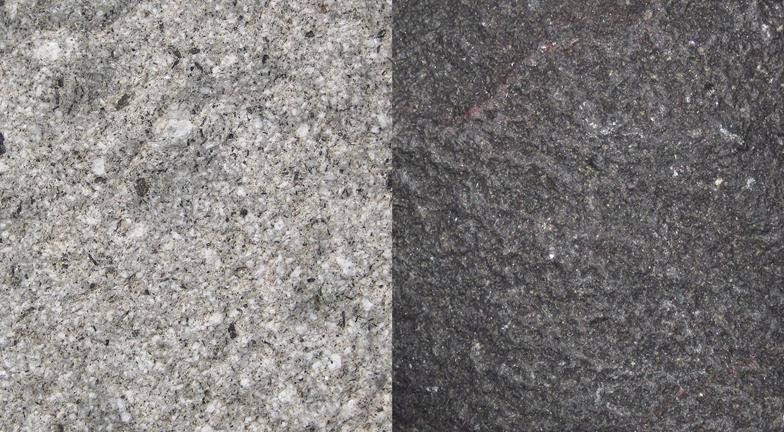Both andesite and basalt are fine-grained, volcanic, or extrusive igneous rocks. Volcanic or extrusive rocks form on the Earth’s surface.
Both can also show other textures like porphyritic, amygdaloidal, ophitic, subophitic, and vesicular. Also, they plot at the same place on the QAPF classification of volcanic rocks.
However, these rocks differ in appearance (color), density, and composition, both chemical and mineralogical. Also, where they occur differs.
Despite these differences, some people may have challenges telling andesite and basalt apart. This post discusses differences.
Before we go further, you must understand what mafic, intermediate, and felsic rocks are. It will help make everything clear.
Mafic means rocks rich in iron, calcium, and magnesium, while felsic rocks are rich in lighter elements like silicon, oxygen, potassium, sodium, and aluminum.
On the other hand, intermediate lies between mafic and felsic in mineral and chemical composition.
Let us now look at the andesite and basalt differences.

1. Andesite and basalt chemical compositions
Andesite is an intermediate rock with 57-63 wt.% silica. It is moderate in sodium and potassium oxide (alkali oxides – Na2O + K2O), i.e., up to 7 wt. % and low in calcium, iron, and magnesium oxide.
On the other hand, basalt is a basic rock. It is low in silica, i.e., 45-52 wt.%, high in iron, calcium, and magnesium oxide, and low in alkali oxides (up to 5%).
Bottomline: Chemically, andesite is high in silica and alkali oxide but low in iron and magnesium oxides. In contrast, basalt is lower in silica and alkali oxides but higher in iron and magnesium oxide.
Andesite and basalt mineral composition
Andesite is an intermediate rock with sodium-rich plagioclase, pyroxene, and a smaller hornblende. It may have biotite and muscovite, with any olivine replaced by enstatite.
The sodium-rich plagioclase has less than 50 mol% anorthite and is usually andesine but can range from anorthite to oligoclase.
On the other hand, basalt is a mafic rock. It mainly contains calcic plagioclase and augite (pyroxene). Also, it may have olivine and other minerals and rarely biotite or hornblende.
The calcium-rich plagioclase in basalt has more than 50 mol% anorthite and is usually labradorite.
Bottomline: Andesite has sodium-rich plagioclase, usually andesine, with less than 50 mol% anorthite, and hornblende with no olivine, while basalt has calcium-rich plagioclase with 50 mol% anorthite, usually labradorite and olivine but often lacks hornblende or biotite.
Physical appearance
The andesite and basalt chemical and mineralogical differences may not be helpful in the field. These rocks have a fine-grained texture. It is impossible to distinguish these two using minerals without a microscope.
Therefore, physical appearance, mostly color, becomes key to distinguishing these rocks in the field.
Andesite is a lighter rock, often light gray to dark gray. Their color index M is less than 35. In contrast, basalt is darker, usually dark gray to black, with a color index of more than 35.
Secondly, check on phenocrysts present for those with porphyritic texture, i.e., large crystals (phenocrysts) embedded in fine-grained matrix or ground.
Andesite will have mostly biotite, orthopyroxene, or hornblende phenocrysts, while basalts have mostly olivine and augite.
Augite is a clinopyroxene with monoclinic crystal, while orthopyroxene has an orthorhombic structure.
Lastly, weigh equal pieces of these rocks. Andesite has a lower density of 2.4-2.8g/cm3 and will be lighter. In contrast, basalt is denser, with a density of 2.9 cm3 or higher. As you do so, don’t forget to factor in the level of vesiculation, i.e., amount of vesicles.
Bottomline: Andesite is lighter in color and less dense and will have phenocrysts of orthopyroxene, hornblende, or biotite, while basalt is denser, darker and will have phenocrysts of olivine and augite.
Where andesite and basalt occur
Where they occur can help indicate whether you have a basalt or andesite.
Basalt occurs in ocean crust, mid-ocean ridges, oceanic islands, and large igneous provinces with minor amounts in volcanic arcs.
On the other hand, andesite dominates volcanic arcs with oceanic crust or mid-ocean ridges having little to no andesite.
Conclusion
Placed side by side, the lighter-colored, less dense rock is andesite, while the darker, denser rock is basalt.
However, be careful as light-colored basalts, i.e., leucobasalts, can appear like andesite. Also, check for which phenocrysts are present, if porphyritic.
